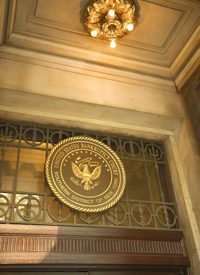
It’s already proven costly to Charles LeCroy, the JP Morgan broker who persuaded the county to refinance its debt in 2004, who was indicted by the SEC in 2009 for fraud in a separate case. And for Larry Langford, a county commissioner at the time, who was sentenced to 15 years in jail for fraud in the present case.
The seeds for the bankruptcy were planted back in 1994 when the Environmental Protection Agency demanded that Jefferson County build a new sewer system. The county complied and raised money through a bond offering that generated $3 billion which was used to build the new plant. LeCroy was the original broker involved in the deal and when he moved to JPMorgan, he used his position to persuade the county to refinance the bonds at lower cost, using something called derivatives. The refinance would lower the county’s interest payments and generate some cash for the county as well. It was that offer and acceptance of a deal that looked awfully good — too good — that set the stage for the bankruptcy filing on Wednesday.
When the financial crisis hit in 2008, the derivatives went against them, and the county’s debt service costs skyrocketed, forcing the county to default. Several of the banks guaranteeing the debt were forced to close, followed by negotiations with the remaining creditors to come to terms acceptable to the county. And a deal was almost consummated in September, consisting of JPMorgan writing down about two-thirds of its outstanding debt in exchange for higher sewer rates for the hapless citizens. But that agreement fell apart when the state legislature couldn’t agree on some of the terms, and a receiver was appointed to resolve the matter.
The receiver decided that the county needed to pay out $75 million immediately and raise sewer rates by 25 percent, which would have been the fifth rate increase in 10 years. The county commissioners took the alternative by declaring bankruptcy and putting resolution of the matter in the hands of a federal judge.
The judge’s powers are limited in a municipal bankruptcy in that he cannot force the sale of assets, but can only approve, or not, the county’s plan on how much they can afford to pay and what kind of haircut the banks and investors will take.
The September deal included a writedown by JPMorgan of $750 million (on top of the $722 million in fines levied on them by the SEC for fraud in the case). The bank said it was “disappointed” that the county decided to declare bankruptcy, indicating in a statement that it had “worked very hard with the county and other creditors to avoid a bankruptcy filing. We offered very substantial financial concessions to make the deal happen.”
The bankruptcy filing is likely to cost the bank and the other creditors even more, but the real cost will ultimately be borne by the taxpayers, most of whom live in the poorer sections of Montgomery. They will be hit with higher increases in sewer fees than would have been required had the September agreement been finalized. John Young, the receiver appointed to run the system, said increases would be “significantly higher” than the 8.2 percent originally called for. And of course, there are the inevitable legal fees, estimated to be in the millions, which will also have to be paid by those same taxpayers.
It all started with the concept of getting something for nothing. The temptation to refinance the original bond issue at lower rates and putting some cash into the county’s coffers was simply too great. Nobody asked what might happen if the assumptions made didn’t work out. It was short-term decision making without considering long-term consequences.
The parallels with the debt position of the United States are obvious: By making promises that could be kept in in the short run, but ignoring the ultimate inevitable consequences in the long run, politicians have now put the United States in the same position as Jefferson County. The ultimate costs to U.S. taxpayers will be much higher than just an increase in sewer fees.



